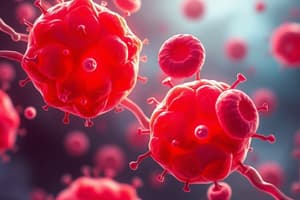Podcast
Questions and Answers
Which of the following is a characteristic of Non-Hodgkin lymphoma?
Which of the following is a characteristic of Non-Hodgkin lymphoma?
- Spleen involvement is rare.
- Typically involves a single group of lymph nodes.
- Usually has a contagious spread pattern.
- Characterized by effacement of nodal architecture. (correct)
Which haemato-lymphoid disorder is most commonly observed in children?
Which haemato-lymphoid disorder is most commonly observed in children?
- Multiple myeloma.
- Chronic Lymphocytic Leukemia (CLL).
- Hairy cell leukemia.
- Acute Lymphoblastic Leukemia (ALL). (correct)
Which of the following statements accurately describes pyogenic osteomyelitis?
Which of the following statements accurately describes pyogenic osteomyelitis?
- It commonly reveals new bone formation. (correct)
- It always presents with granuloma formation.
- It frequently occurs due to Streptococcus bacterial infection.
- It is primarily caused by fungal infections.
Which ovarian tumor is known for its hormone-producing capabilities?
Which ovarian tumor is known for its hormone-producing capabilities?
Which of the following changes are typically observed in acute myocardial infarction?
Which of the following changes are typically observed in acute myocardial infarction?
Flashcards
Non-Hodgkin lymphoma
Non-Hodgkin lymphoma
A type of cancer that usually involves a single group of lymph nodes and has non-contagious spread.
Pyogenic osteomyelitis
Pyogenic osteomyelitis
Bone infection caused by bacteria, often through blood, frequently showing granulomas and new bone formation.
Hormone producing tumor of ovary
Hormone producing tumor of ovary
Tumors in the ovary that produce hormones, examples include Dysgerminoma and Granulosa cell tumor.
Acute myocardial infarction markers
Acute myocardial infarction markers
Signup and view all the flashcards
Benign lesions
Benign lesions
Signup and view all the flashcards
Study Notes
Non-Hodgkin Lymphoma (Patho:151)
- Usually involves a single group of lymph nodes.
- Typically spreads non-contagiously.
- Does not always involve the spleen.
- Characterized by effacement of lymph node architecture.
- Can occur in the gastrointestinal tract (GIT).
Hemato-Lymphoid Disorders in Children (Patho:152)
- Hairy cell leukemia
- Acute lymphoblastic leukemia (ALL)
- Burkitt lymphoma
- These conditions often affect children.
Pyogenic Osteomyelitis (Patho:157)
- Caused by blood-borne infection.
- Primarily caused by bacteria.
- Streptococcus is a frequent causative agent.
- Often shows granuloma formation.
- Characterized by new bone formation.
Hormone-Producing Ovarian Tumors (Patho:158)
- Granulosa cell tumor
- Leydig cell tumor
- These are types of ovarian tumors producing hormones.
Acute Myocardial Infarction (Patho:159)
- Elevated troponin-I levels
- Creatine kinase-MB (CK-MB) elevation observed
- Neutrophilic leukocytosis occurs
- Blood cholesterol levels are not definitive factors in this injury.
- Elevated C-reactive protein (CRP) is a possible marker.
Benign Lesions (Patho:160)
- Choristoma
- Hamartoma
- These classifications represent benign tissue growths.
Studying That Suits You
Use AI to generate personalized quizzes and flashcards to suit your learning preferences.
Description
This quiz covers various pathophysiological aspects of lymphoid disorders, including Non-Hodgkin lymphoma, hematolymphoid disorders in children, and ovarian tumors. Additionally, it explores conditions like pyogenic osteomyelitis and acute myocardial infarction. Test your knowledge on these critical medical topics.




